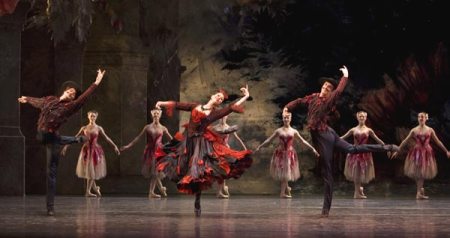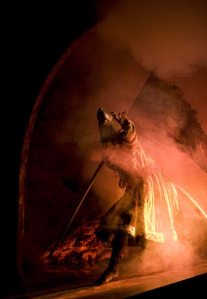Essential for first rate ballet are music and choreography, and this double bill provides them in spades, along with some very fine dancing.
Both ballets involve young lovers splitting apart, yet reunited at the end, and both are choreographed by one of the great masters of the twentieth century, Frederick Ashton. His creations were entirely new, the original choreography for Daphnis and Chloë being lost, and Messager’s score for Two Pigeons being re-orchestrated by John Lanchbery, who rounded it off at the end with a return to the scene at the start, the lovers together again in the studio. Musically and choreographically these are a must-see. Ravel’s music for Daphnis and Chloë is one of the world’s great ballet scores, and though the music for Two Pigeons may be less well known it is simply glorious. Conducting by Koen Kessels was hugely powerful, yet entirely sensitive to the dancers.
The dancing itself was excellent, the corps work very fine, and Elisha Willis gave a lovely performance as both the virginal Chloë and the hot-blooded gypsy girl in Two Pigeons, who causes the young painter to leave his lover and run after her. She filled both roles with conviction, and Robert Parker and Nao Sakuma as the lovers in Pigeons were a delight. Strong dancing all round, with superb sets, costumes and lighting.
The designs for Daphnis and Chloë are John Craxton’s originals for Ashton’s ballet, the gathered skirts for the women and belted trousers and shirtsleeves for the men bringing the classical remoteness of this story into the Mediterranean world so well evoked by Ravel’s score. And the stylised sets, though highly evocative of the period in which they were created, give a timeless background to the story.
In Two Pigeons, Jacques Dupont’s lovely set, with its window to the city and sky, was beautifully lit by Mark Jonathan, the colours of the sky evincing a magical appeal for the anchored freedom of rooftops, and life in the upper floor of a city building. And those pigeons, seeming to fly free outside the window yet with one flying in to join the other at the end, evoke the beauty of this charming story.
These two ballets form a superb double bill, but it will be over in the blink of an eye, so fly down to see it without delay. There is a matinée and evening performance at the London Coliseum on March 14 — for details click here.









